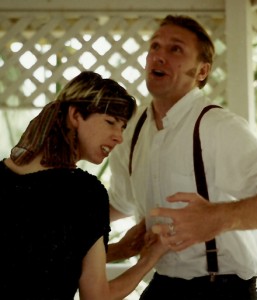When I was a younger kid, I would watch different shows with my parents. A couple of these shows had a similar gag. The Muppet Show had a segment called “At the Dance”, which was similar (a homage maybe?) to Rowan and Martin’s Laugh-In cocktail party segments. These segments were great for the one liners, quick jokes, and rapid sequence of conversations. This was great for a viewer and for a kid, well at least for me as a kid, it was funny and interesting.

As all young children do, I grew a little taller and started to age through the elementary years until I got to the junior high stage in life. It was the first real time I would be able to participate in a “At the Ball” segment in real life. My friends and I thought this was going to be so much fun. Then we arrived at the dance. The horror set in that we would have to dance with a girl, which up until recently in my life at that stage, had been “icky”. We saw one of our friends dancing with another young lady and when the dance was over, he came back to “our side of the wall” and then got it. Everyone over in our area started to tease him, recite the silly childhood chants of “kissing” and ending in baby carriages. This just made me more unlikely to dance with anyone else. And soon, I found myself in the reality of being smack dab in the middle of a Muppet like segment where I watched others have conversations. I would occasionally say something if I was close by, but it was awkward and usually ignored. At times it did feel like I was left out, and the fear of being ridiculed was too much for me to break free.
Luckily I was able to play football to help me ignore those moments. But junior high soon ended, and high school began. It did not get any better. During the freshman years, many of my friends soon had “others” they would rather hang out with. Their conversations revolved around these type of activities. Ones which I was rarely involved in. Dances were no longer the only times that seemed like the Muppet segment. Now it was in regular times in-between classes, before school, and after school. I would say something. Some times, it seemed like the “parrot” of the group, saying the same things over and over, or repeating what others had said. Sometimes it was witty, and the group would laugh, maybe focus on that for a few minutes, then go on discussing the different events of the past weekend and the upcoming weekend. I knew I could no longer be the social leper of the group.

It was not just being able to say odd things, or random thoughts in the social circles I traveled with. That usually resulted in a not too pleasant backlash. OK, maybe not as harsh as the picture indicates, but simply saying anything was not enough. Being witty was not enough. Being a joker was not enough. This did not sustain meaningful conversations, and my ultimate goal: being able to take a girl out on a date, maybe even to a dance. High school brought many opportunities for that. Some people may have thought it a waste of time, or remained scared of what others would say. That was not my fear. My fear was being shot down. I no longer wanted to be on the peripheral of the conversation, I wanted to be able to participate and drive it. This led to many other things, as I saw my friends who did this, they always seemed to have dates (and bum money off me). I wanted that.
I had to break out of my shell. I needed to understand that sometimes, I will strike out. Some girls may say no to me (and they did often). I was tired of watching “At the Dance”, I wanted to be part of it. I hung around my friends, I knew the different things they did, I wanted to be a part of that. Too many of my friends got a head start on me, and I had to play catch up. It was possible, all I had to do was understand that I would not always be the center of attention. But I could contribute to this. If I offered something of interest and was able to interact with others, it did not matter if I brought up the topic, or just participated. I was no longer just throwing out random thoughts in a crowded room, I was getting involved with others. Soon my social circle grew, and more people knew who I was. I was no longer the “odd shy one over against the wall”, I was a human being human with other humans. I learned from them, got to understand them, and they understood me. This led to more dates, and more dances.
I was finally not just watching “At the Dance”, I was part of it. I was able to interact. Instead of talking to other people, I talked with them. Instead of just spewing out random items, or saying the same thing all the time, I was able to interact and understand others. Sure I made mistakes along the way, I am sure everyone does. But in my social circle, people knew and understood me, as I did them. When I did stumble, I did not cry over it, and let despair sink in. Pick yourself up, dust yourself off, and get back in the game. it was more enjoyable when I actively engaged others, rather than just watch their conversations go by.
Sometimes, companies experience the same thing when approaching social media. Is just being “At the Dance” enough, conversations whizzing by, maybe mentions of the company or its products, and the occasional shout out to the noise in the room?